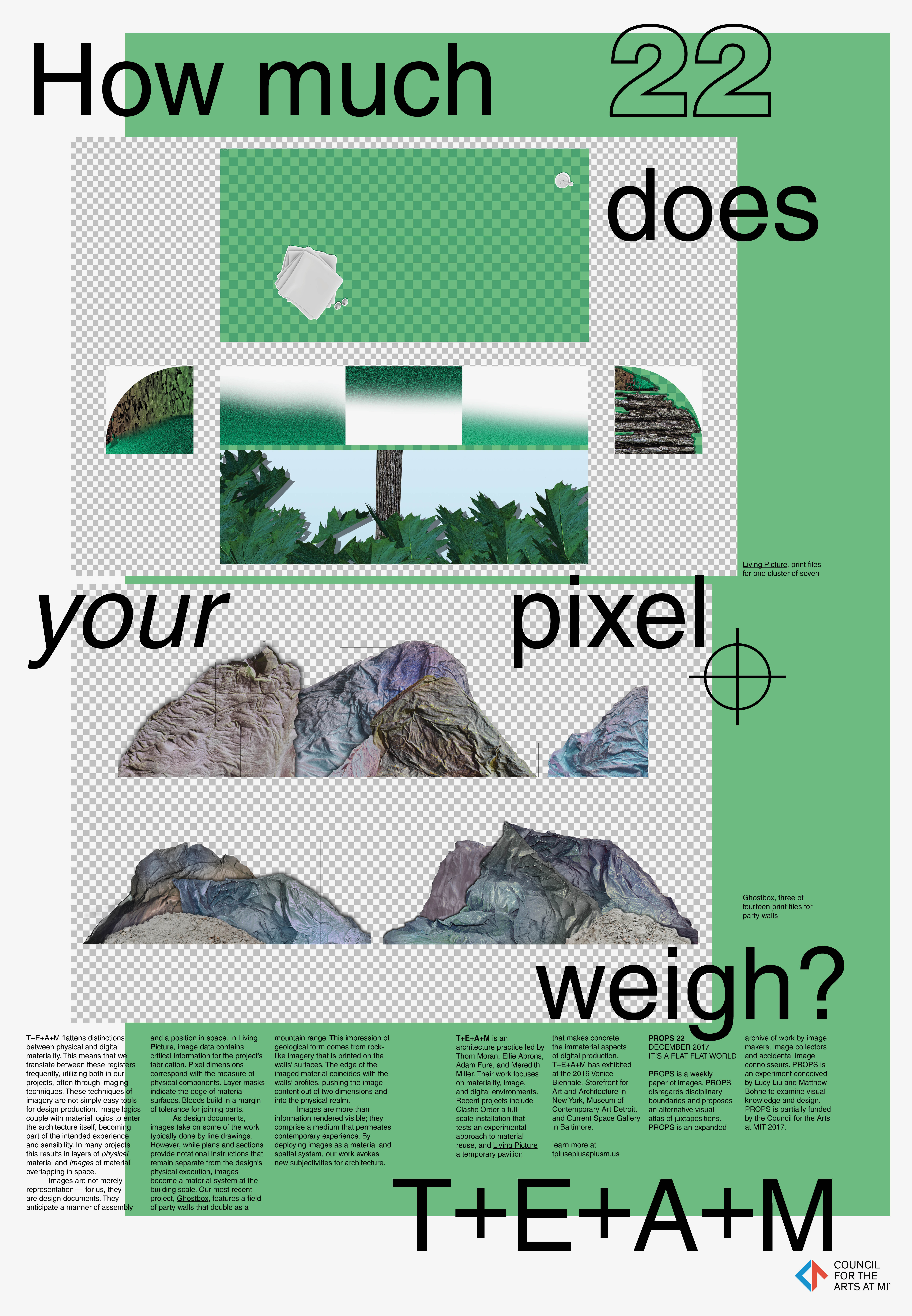

22 HOW MUCH DOES YOUR PIXEL WEIGH
T+E+A+M︎︎︎
T+E+A+M flattens distinctions between physical and digital materiality. This means that we translate between these registers frequently, utilizing both in our projects, often through imaging techniques. These techniques of imagery are not simply easy tools for design production. Image logics couple with material logics to enter the architecture itself, becoming part of the intended experience and sensibility. In many projects this results in layers of physical material and images of material overlapping in space.
Images are not merely representation — for us, they are design documents. They anticipate a manner of assembly and a position in space. In![]() , image data contains critical information for the project’s fabrication. Pixel dimensions correspond with the measure of physical components. Layer masks indicate the edge of material surfaces. Bleeds build in a margin of tolerance for joining parts.
, image data contains critical information for the project’s fabrication. Pixel dimensions correspond with the measure of physical components. Layer masks indicate the edge of material surfaces. Bleeds build in a margin of tolerance for joining parts.
As design documents, images take on some of the work typically done by line drawings. However, while plans and sections provide notational instructions that remain separate from the design’s physical execution, images become a material system at the building scale. Our most recent project,![]() features a field of party walls that double as a mountain range. This impression of geological form comes from rock-like imagery that is printed on the walls’ surfaces. The edge of the imaged material coincides with the walls’ profiles, pushing the image content out of two dimensions and into the physical realm.
features a field of party walls that double as a mountain range. This impression of geological form comes from rock-like imagery that is printed on the walls’ surfaces. The edge of the imaged material coincides with the walls’ profiles, pushing the image content out of two dimensions and into the physical realm.
Images are more than information rendered visible; they comprise a medium that permeates contemporary experience. By deploying images as a material and spatial system, our work evokes new subjectivities for architecture.
Images:
Ghostbox, three of fourteen print files for party walls
Living Picture, print files for one cluster of seven
T+E+A+M︎︎︎ is an architecture practice led by Thom Moran, Ellie Abrons, Adam Fure, and Meredith Miller. Their work focuses on materiality, image, and digital environments. Recent projects include Clastic Order a full-scale installation that tests an experimental approach to material reuse, and Living Picture a temporary pavilion that makes concrete the immaterial aspects of digital production. T+E+A+M has exhibited at the 2016 Venice Biennale, Storefront for Art and Architecture in New York, Museum of Contemporary Art Detroit, and Current Space Gallery in Baltimore.
T+E+A+M flattens distinctions between physical and digital materiality. This means that we translate between these registers frequently, utilizing both in our projects, often through imaging techniques. These techniques of imagery are not simply easy tools for design production. Image logics couple with material logics to enter the architecture itself, becoming part of the intended experience and sensibility. In many projects this results in layers of physical material and images of material overlapping in space.
Images are not merely representation — for us, they are design documents. They anticipate a manner of assembly and a position in space. In
Living Picture

As design documents, images take on some of the work typically done by line drawings. However, while plans and sections provide notational instructions that remain separate from the design’s physical execution, images become a material system at the building scale. Our most recent project,
Ghostbox,

Images are more than information rendered visible; they comprise a medium that permeates contemporary experience. By deploying images as a material and spatial system, our work evokes new subjectivities for architecture.
Images:
Ghostbox, three of fourteen print files for party walls
Living Picture, print files for one cluster of seven
T+E+A+M︎︎︎ is an architecture practice led by Thom Moran, Ellie Abrons, Adam Fure, and Meredith Miller. Their work focuses on materiality, image, and digital environments. Recent projects include Clastic Order a full-scale installation that tests an experimental approach to material reuse, and Living Picture a temporary pavilion that makes concrete the immaterial aspects of digital production. T+E+A+M has exhibited at the 2016 Venice Biennale, Storefront for Art and Architecture in New York, Museum of Contemporary Art Detroit, and Current Space Gallery in Baltimore.